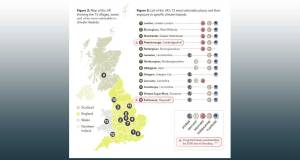- General
- Posted
New EU law will mandate renovation of inefficient buildings
Green groups criticise lack of focus on embodied carbon.
The European Commission is proposing sweeping changes to the way in which energy ratings for buildings are allocated, in a bid to stimulate the retrofit of the worst performing buildings across Europe.
This article was originally published in issue 40 of Passive House Plus magazine. Want immediate access to all back issues and exclusive extra content? Click here to subscribe for as little as €10, or click here to receive the next issue free of charge
The proposed revision to the Energy Performance of Buildings Directive (EPBD) would see energy ratings synchronised across the continent, with the worst 15 per cent of buildings in each country assigned a G rating, and an ‘A’ rating reserved for “zero-emission buildings”. Remaining buildings would be distributed proportionately among the other energy classes, but nations would have some flexibility to define the exact parameters of each class.
The directive says that all public and non-residential buildings must be renovated to at least an F rating by 2027. All residential buildings will have to be improved to F by 2030, and to E by 2033. Member states will also have to publish specific timelines for achieving higher energy performance classes through new national building renovation plans.
The European Commission said that the proposals aim to make energy performance certificates “much clearer, and more reliable and visible, with easy-to-understand information on energy performance”.
The revised directive was published before Christmas as part of the EU’s ‘Fit for 55’ package of measures to cut carbon emissions 55 per cent by 2030. The new EPBD also aims to give effect to the EU’s ‘Renovation Wave’ strategy of doubling the continent’s rate of energy renovation by 2030.
The new EPBD defines a zero-emission building as one with “a very high energy performance in line with the energy efficiency first principle, where the very low amount of energy still required is fully covered by energy from renewable sources at the building or district or community level where technically feasible”. This is an update on the definition of nearly zero energy buildings (NZEBs), the EU’s current standard for new build.
All new public buildings will have to meet the zero-emission definition from 2027, while every new building will have to meet it from 2030. The directive also says that “deep renovation” should be defined as renovation that transforms a building into a zero-emission building.
The directive also contains a proposal that zero-emission buildings do not generate any carbon emissions on site. Though the European Commission says that the directive does not have a mandate to introduce national bans on fossil fuel appliances, it “introduces a clear legal basis for national bans, allowing member states to set requirements for heat generators based on greenhouse gas emissions or the type of fuel used.”
The directive also says that the life-cycle global warming potential of new buildings must be calculated from 2030. The existing requirement that large buildings calculate their life-cycle emissions from 2027 remains in place.
Mixed reaction
Reaction to the publication of the directive was mixed. The climate think tank E3G said that while the revision to the EPBD, “will accelerate the decarbonisation of buildings in the EU, the ambition level does not match the scale of the challenge”. The group’s senior policy advisor Adeline Rochet said that the proposal is a good starting point, but that the “mandatory energy performance standards regime as it is will only allow for marginal improvement, and doesn’t enable renovation at the needed scale and pace”.
The Environmental Coalition on Standards and the European Environmental Bureau both criticised the directive for failing to propose limits on the embodied carbon of new buildings, and failing to mention circularity or resource efficiency with regards to building materials.
“The renovation of European buildings is a once in a lifetime opportunity that we cannot miss,” said Gonzalo Sanchez, a policy officer at the European Environmental Bureau. “It is already happening, and it involves a huge amount of construction materials: if we don’t consider circularity now, we’ll have a huge increase in product related emissions today, and a waste problem in the future”.
The International Union of Property Owners said that the directive would require at least forty million buildings across the EU to be renovated by 2033, and described this as a “herculean” task. “Many member states are already facing a shortage of construction workers – especially skilled workers. And if the deadline seems far away, taking into account the time to adopt and transpose the directive, it will leave at best eight years to achieve this objective,” the group said in a statement.
However, EuroACE, an alliance of companies that promotes energy efficiency in buildings, said that the EPBD, “if ambitiously implemented, has the power to transform the Renovation Wave from strategy to reality.”
A statement from the group said: “The approach proposed by the European Commission, which sees all worst-performing buildings in the EU improve their energy performance by 2030 at the latest (or 2033 depending on the purpose of the building), is the starting point for a systemic change. However, a lot has to be done to ensure that ambitious energy renovations are carried out in a timely and strategic way across the building stock in the EU.”
The proposed directive is now being considered by the European Parliament and the European Council.
Related items
-
 #BuildingLife Series: Director at CORA Consulting Engineers, John Casey
#BuildingLife Series: Director at CORA Consulting Engineers, John Casey -
 September’s AECB environmental construction conference seeks to spark debate among industry experts
September’s AECB environmental construction conference seeks to spark debate among industry experts -
 Climate report warns overheating crisis threatens UK
Climate report warns overheating crisis threatens UK -
 Sustainable building leaders crowned at Exemplar Awards
Sustainable building leaders crowned at Exemplar Awards -
 Barratt launches record passive house scheme
Barratt launches record passive house scheme -
 Green homes and finance join forces for growth
Green homes and finance join forces for growth

